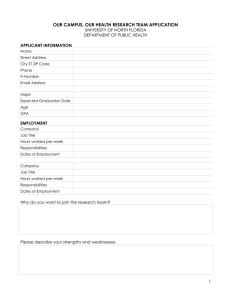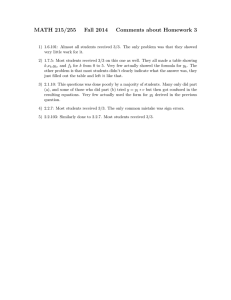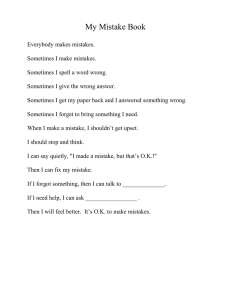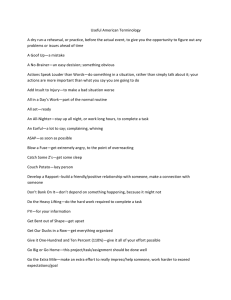Avoidance of Personal Injury Release for Mutual Mistake of Fact
advertisement
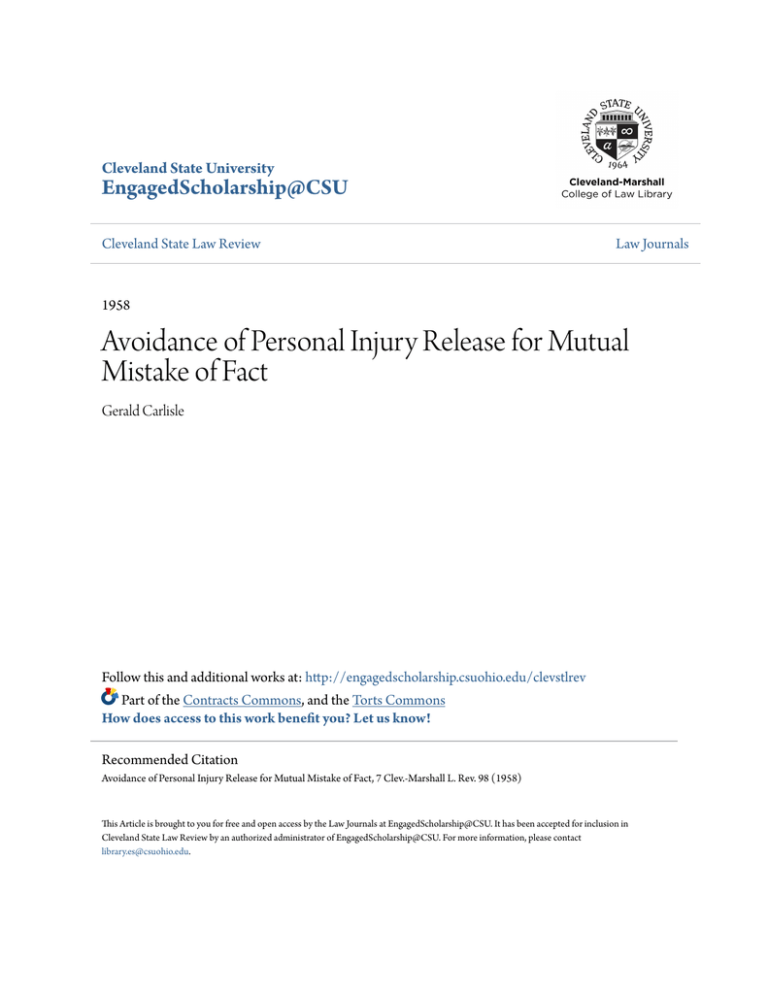
Cleveland State University EngagedScholarship@CSU Cleveland State Law Review Law Journals 1958 Avoidance of Personal Injury Release for Mutual Mistake of Fact Gerald Carlisle Follow this and additional works at: http://engagedscholarship.csuohio.edu/clevstlrev Part of the Contracts Commons, and the Torts Commons How does access to this work benefit you? Let us know! Recommended Citation Avoidance of Personal Injury Release for Mutual Mistake of Fact, 7 Clev.-Marshall L. Rev. 98 (1958) This Article is brought to you for free and open access by the Law Journals at EngagedScholarship@CSU. It has been accepted for inclusion in Cleveland State Law Review by an authorized administrator of EngagedScholarship@CSU. For more information, please contact library.es@csuohio.edu. Avoidance of Personal Injury Release for Mutual Mistake of Fact Gerald Carlisle* L of an unlimited, general release of a claim for all damages for personal injuries, known and unknown, present and future. Then suppose that the consideration is grossly inadequate for the injuries apparent later, but fully adequate for the situation as it seemed at the time of release. The releasor is now sick, sore, sorry and definitely suffering from injuries more serious, of greater extent, or of a different nature than those known at the time the release was granted. The releasor now desires to avoid this bar, and to bring action against the tortfeasor. It is not difficult to see that the instrument termed a release, is a contract that clearly portrays a meeting of the minds. It explicitly states a release from liability for known, unknown, present, and future injuries. In attempting to avoid such a release the party ordinarily may allege the grounds he may have under the law of contracts. In personal injury releases, these grounds usually take the form of charges of fraud or misrepresentation,' coercion, 2 inequitable circumstances,3 mutual mistake of law,4 unilateral mistake of fact,5 inadequate consideration, or mutual mistake of fact. 7 The fraud charge, along with its kindred charges of coercion, inequitable conduct, and misrepresentation, when proved provides a fair and reasonable cause for avoidance of the release. While ET US TAKE THE CASE * A. B., College of Wooster; a second year student at Cleveland-Marshall Law School; and Acting Clerk of Court, Euclid Municipal Court, Euclid, Ohio. 1 Birmingham Ry., Light & Power Co., v. Jordan, 170 Ala. 530, 54 S. 280 (1911). For other example of fraud see table at end of article. 2 Ross v. Koenig, 129 Conn. 403, 28 A. 2d 875 (1942). 3 Keller v. Wolf, 58 N. W. 2d 891 (Minn., 1953); Norris v. Cohen, 27 N. W. 2d 277 (Minn., 1947). 4 Carpenter v. Detroit Forging Co., 191 Mich. 45, 157 N. W. 374 (1916). 5 Sullivan v. Elgin, J. & E. Ry. Co., 331 Ill. App. 613, 73 N. E. 2d 632 (1947). 6 Doyle v. Teasdale, 263 Wis. 328, 57 N. W. 2d 381 (1953). 7 Jordan v. Brady Transfer and Storage Co., 226 Iowa 137, 284 N. W. 73 (1939); McCarthy v. Eddings, 127 P. 2d 883 (Colo., 1942); Fraser v. Glass, 311 IM. App. 336, 35 N. E. 2d 953 (1941). For other citations see table at end of article. Published by EngagedScholarship@CSU, 1958 1 MISTAKEN PERSONAL INJURY RELEASE the mutual-mistake-of-fact defense is the most controversial, it nevertheless is becoming more widely accepted every year. We shall deal here with the defense of mutual mistake. Mutual Mistake of Fact A Federal Court applying Oklahoma law describes a mutual mistake of fact as a mistaken "past or present fact, material to the agreement .... The release will not be set aside where mistake is one of the prophesy or opinion of future development or permanency." 8 In this 1939 Oklahoma decision, the factual situation showed a head injury being diagnosed by a physician as a slight concussion. In consideration of a full release of all past and present, known and unknown injuries, the plaintiff received $250.00. Subsequently, it was discovered that her head injuries were of a different and more permanent type. The Court set aside the release on the grounds of mutual mistake of fact. An Illinois Appellate Court avoided a release for mutual mistake of fact as to the "nature and seriousness" of injuries, and added that only a "reasonably diligent search for injuries need have been made by the releasor before releasing." 9 Another example of mutual mistake is shown in Southwest Machine & Pump Co. v. Jones.10 Here the facts of a displaced sacro-iliac joint and splinters of glass in the person's temple had not shown up on X-rays taken previous to the release. Inadequate consideration, and mutual mistake as to the extent and character of the injuries were the reasons given for the avoidance. In the above examples and in many others releases have been avoided for mutual mistake of fact as to the nature and seriousness of injuries, as to the extent and character of the injuries, and because the injury was later found to be of a more permanent type than previously expected. Mistakes not included as mutual mistakes of fact have been those of prophesy, or opinion of future development, or of permanency. Thus some courts would allow an avoidance for a mistake in diagnosis of permanency or seriousness of injury, while others expressly would not do so. This leads not to certainty, but rather to confusion. 8 Tulsa City Lines v. Mains, 107 F. 2d 377 (C. C. A. 10, 1939). 9 Fraser v. Glass, 311 Ill. App. 336, 35 N. E. 2d 953 (1941). 10 Southwest Pump & Machinery Co. v. Jones, 87 F. 2d 879 (C. C. A. 8, 1937). http://engagedscholarship.csuohio.edu/clevstlrev/vol7/iss1/10 2 CLEVELAND-MARSHALL LAW REVIEW In attempting to clarify somewhat the concept usually meant by the courts' term-mutual-mistake-of-fact-we may safely say that, in order to justify an avoidance, most courts look for the appearance of an injury that was completely overlooked at the time of the release. Needless to say, this search and categorization leads the law into the interesting and specialized field of medico-legal study. 1 A 1957 Florida decision typifies quite well the vague area of distinction between mistake as to injury and mistake as to prophesy or consequences. Here a woman, injured in a bus accident, signed a release for a few dollars, after her doctor had said that the injury was nothing serious, but only a mild injury to her back. Then it turned out to be a seriously herniated disc. She sought rescission of the release, citing Boole v. Florida Power & Light Co.,1 2 where an injury diagnosed as a chest bruise and settled for fifteen dollars, turned out to be a fatal heart injury, and it was held to be a jury question in proceedings for rescission. The Boole case represented a mistake as to the injury itself, the court reasoned. But, here, any mistake made was only one as to the ultimate consequences, not as to the injury itself-i.e., only a mistake in valuation. Said the court: "While a release executed pursuant to a mistake as to a past or present fact may on proper showing be set aside... unknown or unexpected consequences of known injuries will not result in invalidating the release. An erroneous opinion or error of judgment respecting future conditions as a result of presently known " facts will not justify setting the release aside ... In the DeWitt case a great amount of medical testimony showed that the herniated disc was a possible future result of stresses present, and noticed by the plaintiff's physician, before the release. This case is one of the best examples of a precise holding to the theory of avoidance only on mistake of past or present fact. Here again, it is interesting to note that the release in the DeWitt case, among other things, released the tortfeasor from liability for "any and all known and unknown personal injuries." This was "typical of such documents," 13 the court said. 11 DeWitt v. Miami Transit Co., 95 S. 2d 898 (Fla., 1957). 12 147 Fla. 589, 3 S. 2d 335 (1941). 13 DeWitt case, n. 11. Published by EngagedScholarship@CSU, 1958 3 MISTAKEN PERSONAL INJURY RELEASE Mutual Mistake of Fact-Not the Answer Avoidance of a release on the ground of mutual mistake of fact seems, in some ways, to make a mockery of contractual release of any-and-all-known-and-unknown-injuries. The intent shown by the signing of such an instrument could not be more plain; yet the courts persist in avoiding such releases because some injury was unknown at the time of contracting. Is this not a contradiction of legal reasoning! One clearly contracts to release for unknown injuries, and yet one does not. The courts attempt to encourage settlements out of court, yet they void the release contracts on the grounds which are in direct conflict with the expressed intent of both parties to those contracts; that 14 is, in releases for known or unknown injuries. A Sound Reason for Avoidance An older and better reasoned theory on avoiding releases is found in Morris v. Seaboard Air Line Ry. 15 There a rider had merely bumped his head in a train wreck, and felt that the five dollars paid as consideration for a release was sufficient to pay for his slight pain and his taxi fare. The release also indicated that this consideration was to pay for any and all known or unknown injuries. Later, he found he was suffering from a very serious brain injury. This court reasoned that "where a party who has a claim against another for personal injuries agrees upon a settlement of his claim, and accepts a sum of money or other token of value in settlement of such a claim, he is, in the absence of fraud, or concealment, concluded by the settlement .... Under any other rule than that here announced, no one could ever make a settlement and take a release with the assurance that it would not be attacked and set aside on the statement of the person who executed it that when he signed it he was mistaken as to the extent of his injuries." This rule respects the meeting-of-the-minds theory that underlies a contract and the bargain duly made in the contract of release. Still, the cry of the injured party who is sick and sorry should not go unheard, even under the general rule that the release should stand in the absence of fraud or concealment. It is well known that some ugly instances of injuries developing after release result from the speedy action of the claim See Kowalke v. Milwaukee Electric R. & Light Co., 103 Wis. 472, 79 N. W. 762 (1899); Larson v. Sventek, 211 Minn. 490, 1 N. W. 2d 608 (1942). 15 Morris v. Seaboard Air Line Ry., 99 S. E. 133 (Ga., 1919). 14 http://engagedscholarship.csuohio.edu/clevstlrev/vol7/iss1/10 4 CLEVELAND-MARSHALL LAW REVIEW adjustor who seeks to obtain signatures at the very scene of the accident, or as soon as possible thereafter. Such instances also may result from the eagerness of the impatient claimant. Many of these unfortunate claimants would not be in a sorry situation if they had waited even for a short time. In Morris v. Seaboard, mentioned above, the claim was adjusted and release given within twenty-four hours after the accident. This ordinarily is not even long enough for a whiplash victim to become stiff and sore. Such situations unfortunately are not uncommon. They suggest a need for better discipline of investigators and adjustors in some companies. In North Dakota, by statute, a release is voidable if made while the injured party is disabled or within thirty days after this injury. Thereafter, personal representatives may avoid it within six months. 16 This statute represents a sound and progressive improvement in the law governing the problem of the hasty release. In essence, it seems to be desirable to make the law such that we will not be compelled to ignore basic-bargain principles of contracts in order to provide for the rights of persons who are too hasty in signing releases of personal injury claims. Following is a chart of the law of the several states as to the elements necessary for avoiding personal injury releases. State Alabama Arkansas Arizona California Colorado Basis for Avoiding a Release 17 Fraud or misrepresentation 18 Mutual mistake of fact Intent of releasor governs (fraud)19 Mutual mistake of fact202 Mutual mistake of fact ' Sec. 9-0808 and Sec. 9-0809. Also, Anno. Code of Md., Art. 79, Sec. 11, provides that a release, if signed within five days after injury, may be avoided within sixty days. 17 Birmingham Ry., Light and Power Co. v. Jordon, 170 Ala. 530 54 S. 280 (1911). 18 Ozan Graysonia Lumber Co. v. Ward, 66 S. W. 2d 1074 (Ark., 1934). 19 Fagerberg v. Phoenix Flour Mills, 50 Ariz. 227, 71 P. 2d 1002 (1937). 20 Kostick v. Swain, 253 P. 2d 531 (Calif., 1953); Graham v. Atchison, T. & S. F. Ry., 176 F. 2d 819 (C. A. A. 9, 1949); Jordon v. Guerra, 136 P. 2d 367 (Calif., 1943); Calif. Civil Code, Sec. 1542: "A general release does not extend to claims which the creditor does not know or suspect to exist in his favor at the time of executing the release, which if known by him must have materially affected his settlement with the debtor." Also construed to apply to personal injury releases. See Backus v. Sessions, 17 Calif. 2d 380, 110 P. 2d 51 (1941); O'Meara v. Haiden, 204 Calif. 354, 268 P. 334 (1928); Note, 1 Stanford L. R. 298 (1949). 21 McCarthy v. Eddings, 127 P. 2d 883 (Colo., 1942). 16 No. Dak. Rev. Code (1943) Published by EngagedScholarship@CSU, 1958 5 MISTAKEN PERSONAL INJURY RELEASE Connecticut Fraud or coercion 22 Delaware Florida Georgia Idaho Illinois Fraud or misrepresentation Indiana Iowa Kansas Kentucky Maine Maryland Massachusetts Michigan Minnesota Mississippi 23 Mutual mistake of fact 24 Mutual mistake of fact Mutual mistake of fact 25 26 Serious mistake by28 one party; 27 also mutual mistake of fact 29 Mutual mistake of fact 30 Mutual mistake of fact 31 Mutual mistake of fact 32 Mutual mistake of fact 33 Fraud or misrepresentation If signed within five days after 34injured, may be voided within sixty days slight indication of Fraud or concealment 35 mutual mistake Mutual mistake of fact and law36 Unilateral mistake if one was ignorant of fact and other was37 aware of fact, or if inequitable conduct 38 Misrepresentation of law Ross v. Koenig, 129 Conn. 403, 28 A. 2d 875 (1942). Kiloski v. Penn. R. Co., 96 F. Supp. 321 (D. C., Del., 1951); Tatman v. Philadelphia, I. & W. R. Co., 85 A. 716 (Del., 1913). 24 Boole v. Florida Power & Light Co., 147 Fla. 589, 3 S. 2d 335 (1941); DeWitt v. Miami Transit Co., 95 S. 2d 898 (Fla., 1957). 25 Morris v. Seaboard Airline Ry., 99 S. E. 133 (Ga., 1919). 26 Estes v. Magee, 62 Idaho 82, 109 P. 2d 631 (1940). 27 Sullivan v. Elgin, I. & E. R. Co., 331 Ill. App. 613, 73 N. E. 2d 632 (1947). 28 Fraser v. Glass, 311 Ill. App. 336, 35 N. E. 2d 953 (1941). 29 Automobile Underwriters v. Smith, 133 N. E. 2d 72 (Ind., 1956); Gumberts v. Greenburg, 115 N. E. 2d 504 (Ind., 1953). 30 Jordan v. Brady Transfer and Storage Co., 226 Iowa 137, 284 N. W. 73 (1939). 31 Hodgson v. Mutual Benefit Health and Accident Assoc., 153 Kans. 511, 112 P. 2d 121 (1941). 32 Yutz v. Commonwealth Life Ins. Co., 264 Ky. 142, 94 S. W. 2d 326 (1936). 33 Borden v. Sandy River & R. L. R. Co., 110 Me. 327, 86 A. 242 (1913). 34 Anno. Code of Md. Art. 79, Sec. 11. 35 Tewsbury v. Fellsway, 319 Mass. 386, 65 N. E. 2d 918 (1946). 36 Carpenter v. Detroit Forging Co., 191 Mich. 45, 157 N. W. 374 (1916). 22 23 Keller v. Wolf, 58 N. W. 2d 891 (Minn., 1953); Norris v. Cohen, 223 Minn. 471, 27 N. W. 2d 277 (1947). 38 Penn. Mut. Ins. Co. v. Nunnery, 176 Miss. 197, 167 S. 416 (1936). 37 http://engagedscholarship.csuohio.edu/clevstlrev/vol7/iss1/10 6 CLEVELAND-MARSHALL LAW REVIEW Missouri Montana Nebraska New Hampshire New Jersey New Mexico New York North Carolina North Dakota Ohio Oklahoma Pennsylvania South Carolina South Dakota Tennessee Texas Mutual Mutual Mutual Mutual mistake mistake mistake mistake of of of of fact 3 9 fact 40 fact 4 1 fact 42 43 Fraud or deceit 44 Mutual mistake of fact 45 Mutual mistake of fact 46 Mutual mistake of fact or within thirty days If given while disabled 47 after injury 4 Fraud or misrepresentation 49 Mutual mistake of fact 50 Fraud or misrepresentation Mutual mistake of fact5 ' 52 Mutual mistake of fact 53 Mutual mistake of fact circumstances and ignoIf given inequitable 54 rance (fraud) Utah 39 40 55 Mutual mistake of fact Cleghorn v. Terminal R. Ass'n. of St. Louis, 289 S. W. 2d 13 (Mo., 1956). Carlson v. Northern Pacific R. Co., 268 P. 549 (Mont., 1928). 41 LaRossa v. Union Pacific Ry. Co., 142 Neb. 290, 5 N. W. 2d 891 (1942); Schmidt v. City of Lincoln, 151 Neb. 317, 37 N. W. 2d 500 (1949). 42 Poti v. New England Road Machinery Co., 83 N. H. 232, 140 A. 587 (1928); Rickle v. Wyoming Valley Paper Mills, 93 N. H. 191, 38 A. 2d 78 (1944). 43 Reinheart v. Wilbur, 30 N. J. Super. 502, 105 A. 2d 415 (1954); Heuter v. Coastal Air Lines, 12 N. J. Super. 490, 79 A. 2d 880 (1951). 44 Mendenhall v. Vandeventer, 229 P. 2d 457 (N. Mex., 1956). 45 Wheeler v. State, 286 App. Div. 310, 143 N. Y. S. 2d 83 (1956). 46 Cheek v. Southern Ry. Co., 214 N. C. 152, 198 S. E. 626 (1938). 47 No. Dak. Rev. Code (1943) Sec. 9-0808. Connelley v. U. S. Steel Co., 161 Ohio St. 448, 119 N. E. 2d 843 (1954). 49 Tulsa City Lines v. Mains, 107 F. 2d 377 (C. A. A. 10, 1939); Chicago R. I. & P. Ry. Co. v. Perkins, 242 P. 535 (Old., 1925). 50 Seely v. Citizens Traction Co., 179 Pa. 334, 36 A. 229 (1897); Kane v. Chester Traction Co., 186 Pa. 145, 40 A. 320 (1898). 51 Lawton v. Charleston, & W. C. Ry. Co., 91 S. C. 332, 74 S. E. 750 (1912). 52 Peterson v. Kemper, 70 So. Dak. 427, 18 N. W. 2d 294 (1945); Nilsson v. Kruger, 69 So. Dak. 312, 9 N. W. 2d 783 (1943). 53 Metropolitan Life Ins. Co. v. Humphry, 167 Tenn. 421, 70 S. W. 2d 361 (Tenn., 1934). 54 Premeaux v. Socony-Vacuum Oil Co., 144 Tex. 558, 192 S. W. 2d 138 (1946); Harris v. Sanderson, 178 S. W. 315 (Tex., 1944). 55 Kirchgestner v. Denver & R. G. W. Ry. Co., 218 P. 2d 685 (Utah, 1950). 48 Published by EngagedScholarship@CSU, 1958 7 MISTAKEN PERSONAL INJURY RELEASE Virginia Washington West Virginia Wisconsin Mutual mistake of fact 56 57 Mutual mistake of fact Federal Statute Hawaii Mutual mistake of fact 60 Mutual mistake of fact 6' Fraud or misrepresentation Mutual mistake of fact sideration59 8 inadequate con- 56 Atlantic Greyhound Lines of West Virginia v. Metz, 70 F. 2d 166 (C. A. A. 4, 1934). 57 Roberts v. Pacific Telephone & Telegraph Co., 93 Wash. 274, 160 P. 965 (1916). 58 Janney v. Virginian Ry. Co., 119 W. Va. 249, 193 S. E. 187 (1937). 59 Doyle v. Teasdale, 263 Wis. 328, 57 N. W. 2d 381 (1953); Jandvt v. Milwaukee Auto Ins. Co., 255 Wis. 618, 39 N. W. 2d 698 (1949). 60 Federal Employers Liability Act, Sec. 1 et seq.; Sec. 5; 45 U. S. C. A., Sec. 51 et seq., Sec. 55; Kilosky v. Penn. Ry. Co., 96 F. Supp. 321 (D. C. Del., 1951). 61 Silva v. Robert Hind Ltd., 32 Hawaii 936 (1934). http://engagedscholarship.csuohio.edu/clevstlrev/vol7/iss1/10 8

